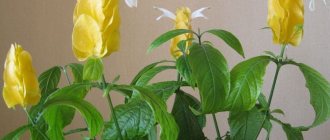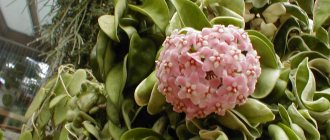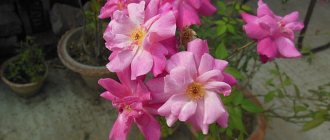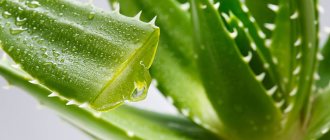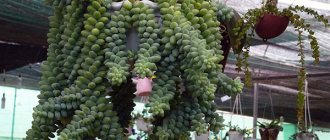The beautiful clematis flower has several other names, such as clematis, lozinka. This is a representative of the Ranunculaceae.
A perennial plant common in the subtropics of the Northern Hemisphere. There are approximately 300 species.
General information about clematis
Among the numerous representatives of clematis there are subshrubs, shrubs, and herbaceous plants, although the majority are represented by a group of vines.
All species have one of two types of root systems: taproot and fibrous. Flower shoots can develop from above-ground buds or from the underground part. The leaves can be simple or compound, usually green, sometimes purple.
Simple forms of clematis are represented by a flower filled with stamens and pistils, making the plant resemble a spider.
The shade range of the plant is varied - from pale pink to rich red, from sky blue to deep blue, as well as snow-white and yellowish inflorescences.Description
The clematis species combines many plants - both species and hybrids. The plants have adapted well to the difficult conditions of our vast territories and are actively spreading throughout the garden plots and apartments of amateur gardeners.
What does the plant look like?
Clematis belongs to the Buttercup family. Most of the representatives of the genus are vines that actively cling to support, which allows them to be used for vertical gardening.
The average length of a loach is about 3 m, but plants that stretch more than 8 m are not uncommon. There are also non-climbing climbing bushes, whose height does not exceed 2.5 m. Their feature is the ability not to cling, but as if leaning on a support.
Clematis and bush forms are present in a huge variety. Their height usually does not reach a meter mark , which makes growing in containers possible.
Based on the shape of the shoots, clematis are divided into herbaceous (which dies off in the winter) and woody (which overwinter well in the ground).
Leaf blades vary depending on the varietal characteristics of the plant. They can be:
- simple, but at the same time whole or dissected;
- complex (opipinnate, trifoliate or double trifoliate).
Usually the leaves are arranged in pairs, but there are clematis with a triple arrangement of leaves.
Some varieties, for example, Clematis Jacquemman, have mixed foliage: most of the stem is covered with imparipinnate leaves, but at the tops of the shoots there are simple leaf blades.
The color of the leaves also varies. The most common options:
- light green;
- dense green;
- bluish-green;
- gray;
- burgundy
The prince's flowers deserve special attention.
Flowers are devoid of petals, and what is considered to be petals in clematis is represented by variously colored sepals.
Flowers can be either very large or small ; they are located singly on the shoots or can be collected in paniculate inflorescences.
Bracts are usually:
- white;
- yellow;
- carmine red;
- purple;
- purple;
- blue;
- blue.
In some varieties, a rather wide longitudinal contrasting stripe may run down the center of the bract petal.
The structure of the clematis root system also differs. Some plants have an extensive (up to 2 meters in diameter), but not too deeply penetrating into the soil, fibrous root system. While others are distinguished by their tap root system extending to a decent depth.
Those clematis that have a taproot system do not tolerate transplantation well. They should be immediately planted in a permanent place and not disturbed again.
Varieties of varieties
There are different classifications of lozinki. Fans classify them by flower size: small-, medium- and large-flowered plants. But according to the international division, clematis varieties look like this:
- Group “A” – plants that bloom on the shoots of the previous season (Alpina, Florida, Montana).
- Group “B” – fresh and last year’s shoots bloom (Lanuginosa, Patens).
- Group “C” – forming flowers on shoots of the current period (Jacman, Vititsella, Integrifolia).
Growing weeds
There are several ways to grow this plant.
From seeds - here they are divided into groups, which is influenced by the size of the seed and the duration of the germination period:
- Instances with large seed sizes that take quite a long time and do not always germinate evenly:
- Clematis with medium seeds;
- Plants with small seeds that germinate quickly (from 2 weeks to 4 months)
If the seeds were collected in the current period, then they will germinate much better.
Small seeds are sown in March-April, medium-sized ones - after the long New Year holidays, large ones - at the end of the fresh harvest in the autumn-winter period.
First, the seeds are soaked in water for 10 days, then the seeds are laid on a substrate of soil, pitch and peat and sprinkled with a layer of sand, covered with a glass plane. Temperature for germination is from 25 to 30 Celsius.
Plant seedlings must be protected from direct sunlight. When the first full-fledged leaves form, the plants are cropped into independent containers.
When truly warm spring days arrive without frost, clematis is planted in the soil at intervals of at least 20 cm.
Care and cultivation from seeds
It should be noted that not all varieties of clematis can be grown from seeds . Hybrid forms reproduce well by self-sowing, but sprouted shoots will not retain the characteristics of the mother plant, so seed propagation in this case does not make sense.
In addition, there is another difficulty - clematis seeds purchased in a store, like collected seed material, need stratification (cooling for a long time).
Many flower lovers note that planting princely seeds requires considerable endurance and patience from the gardener.
Sowing seeds
Many gardeners recommend planting in the autumn so that the seeds undergo natural stratification under the snow.
The fact is that for many types of clematis, the cold aging period should take more than a month . It will be more convenient to carry out the procedure naturally, rather than taking up space in the refrigerator with a container of seeds.
To plant seedlings, seeds are still sown in early spring, stratified artificially.
To improve seed germination, it is recommended to soak them in water for at least 5 days, renewing it daily. This procedure softens the cover and improves germination.
For planting clematis, choose a regular container; the seeds are not buried too deep.
The soil for seedlings is made from a mixture of coarse river sand (it needs to be calcined in the oven to be disinfected) and peat, taken in equal proportions.
The plantings are moistened and covered with glass or cling film and placed in a warm, well-lit place. Seed germination takes quite a long time , so you need to be patient and remember to ventilate the plantings daily.
Caring for clematis
Clematis requires regular watering in its planting and care. Plants should be watered as usual once a week. In hot weather - up to three times in 7 days. Up to 20 liters are poured into a young seedling, and up to 40 liters into a mature one. at a time.
Fertilizing of plants is carried out during the period of active growth with nitrogen fertilizers, during budding - with potassium compounds, as soon as the flowers have bloomed - with phosphorus.
Every year in spring, clematis needs to be fertilized with a mixture of chalk and dolomite flour.
Planting and care in open ground
In general, clematis is not a very demanding crop, but in order for the vine to take root well and bloom regularly, you need to meet some requirements for planting and maintaining the plant.
How to preserve a seedling before planting
If young clematis was purchased at an inopportune time (for example, it is still too cold to plant in the ground), then it is important to preserve it until planting in a permanent place .
In this case, the pot with the seedling is placed in the brightest place (ideally placed on a southern windowsill). It is recommended to treat the soil with “Fitosporin” or a pink solution of potassium permanganate.
This measure will help destroy fungal spores if they were introduced into the ground. The seedling itself is sprayed with Epin solution; it is also a good idea to feed the clematis with vermicompost.
How to plant clematis correctly
Plants are planted only after the return of night frosts have completely passed.
Before planting clematis in open ground, you need to harden it. A week before the intended planting, they begin to take the pot with it outside to a slightly shaded area. Before planting, the plant must spend at least 24 hours outdoors.
Planting technology:
- The planting hole should be spacious and deep enough, regardless of the type of clematis root system.
- The dimensions of the hole are 60x60x60 cm.
- A drainage layer of at least 10 cm must be poured onto the bottom. If in the spring the groundwater rises high, this measure will help prevent prolonged contact of the roots with moisture.
- For planting, prepare a nutrient substrate from turf soil, peat and humus, taken in equal parts, and add a glass of wood ash.
- The substrate is poured into the hole and lightly compacted.
- The seedling is installed at the same height as it was located in the pot.
Make sure that the root collar of the plant is above the ground level.
After planting, clematis is well watered.
What time to plant
You can plant a seedling both in spring and autumn . Spring planting is usually practiced in regions with harsh winters.
This is done so that the clematis has time to take root well over the summer and quietly overwinter.
Autumn planting is practiced in southern regions with long, warm autumns and mild winters.
Plant the plant at least a month before the first frost . This time is enough for the clematis to take root properly.
Landing place
When choosing a place for planting, it is important to take into account the peculiarity of the vine: the roots prefer to be in the shade , but the apical shoots of clematis require a lot of sunlight.
It is optimal to plant the princeling in such a way that its lower part is covered with ornamental grasses or low flowers.
Hosta will be an excellent companion for clematis. It does an excellent job of shading the roots and does not block the sun's rays necessary for shoots.
Soil requirements
Avoid heavy, poorly moisture-conducting soils for planting clematis.
It is strictly not recommended to plant princeling near trees. The liana will begin to compete with the powerful root system of the tree and will inevitably lose.
In general, planting clematis requires fertile, well-drained, breathable soil with a neutral or slightly acidic pH.
Watering
Water the princeling at least once every 7 days . Young plants require 10 to 20 liters of water per watering, while for adult vines this volume reaches 40 liters.
Watering at the roots is not recommended, as this may cause them to become exposed.
Make a trench around the clematis trunk and water it. A couple of days after watering, the soil in the tree trunk circle is loosened to prevent the formation of a hard, airtight crust.
Supports for clematis
Since most members of the genus are climbing vines, they require support for normal development . You can plant clematis next to the gazebo, and it will climb its walls, entwining them.
If the prince is planted at some distance from suitable walls, he will need appropriate support.
The material can be anything, the main thing is that the vine can cling freely. It is optimal to use fine mesh, picket fences or poles with holes.
Feeding
Young clematis do not need additional feeding in the first 2–3 years after planting, since they have enough nutrients supplied during planting.
Adult plants are fertilized twice per season . Before the growing season begins, nitrogen complexes are added to the soil, and during flowering, potassium-phosphorus fertilizers are used.
Wintering
Despite their apparent fragility, many varieties of clematis tolerate even harsh winters with little snow without much damage .
Of course, for difficult regions you should choose frost-resistant varieties, but with minimal shelter (mulching the root zone), many plants can withstand frost without damage.
Cutting the vine
Clematis pruning is carried out both at the growth stage and in winter. In the first A-group of clematis, only weak shoots are pruned. This is best done after flowering has finished, around June.
Pruning of the B-group is carried out at a distance of up to one meter, preserving from 2 to 5 pairs of young buds, removing weak shoots.
In the C-group, pruning is carried out in several stages during the growing season.
After flowering, clematis must be prepared for wintering. To do this, the neck should be covered with a solution of 2% copper sulfate, a bucket of humus should be poured under the root and hilled up to a height of 15 cm.
Dry leaves are poured on top of the plant and covered with a wooden box, covering it on top with protective material in the form of roofing felt, roofing felt or another. To prevent it from being blown away, a brick or layer of earth is placed on top.
Photos of clematis flowers show that for proper growth and an attractive appearance, this plant needs to be supported. It can be designed in the form of arches, fans, pyramids.
To do this, it is worth selecting durable materials, since an adult clematis plant has a large mass.
